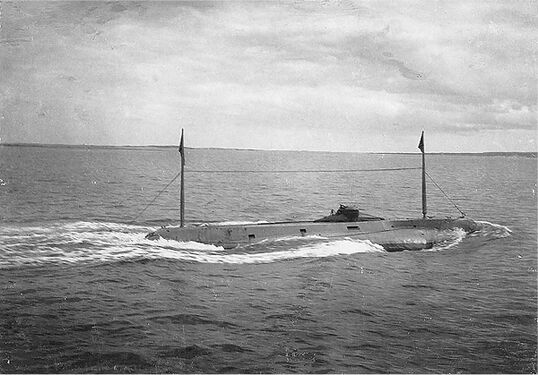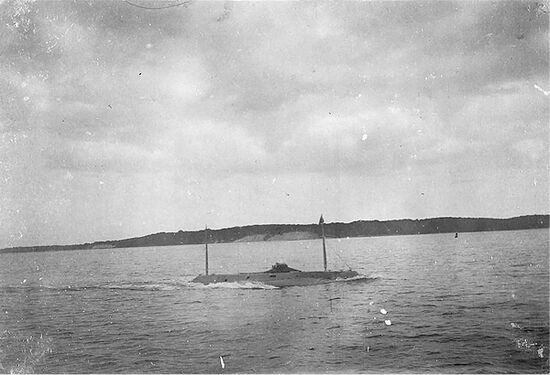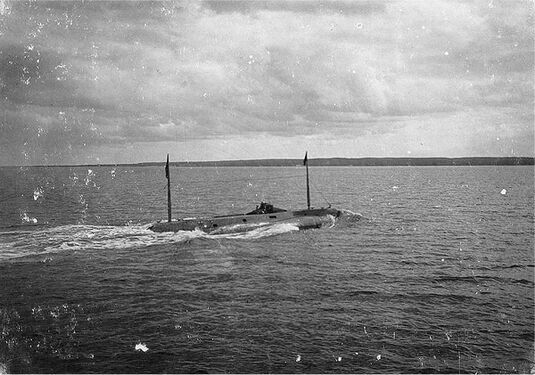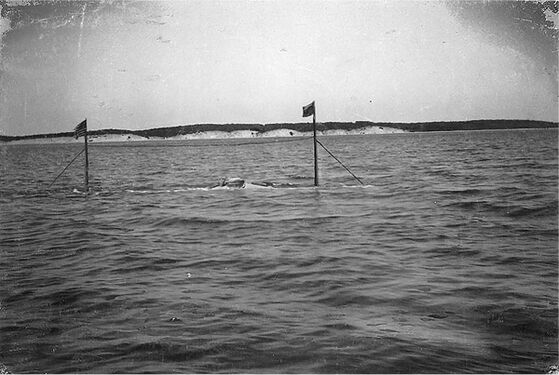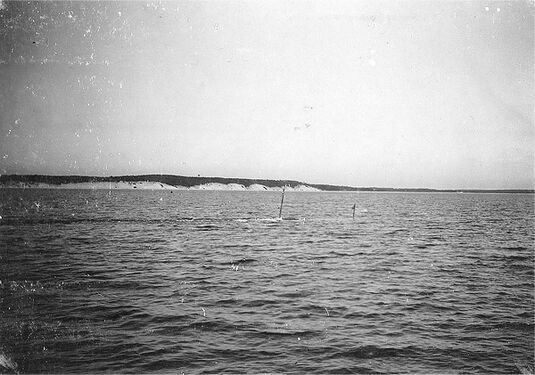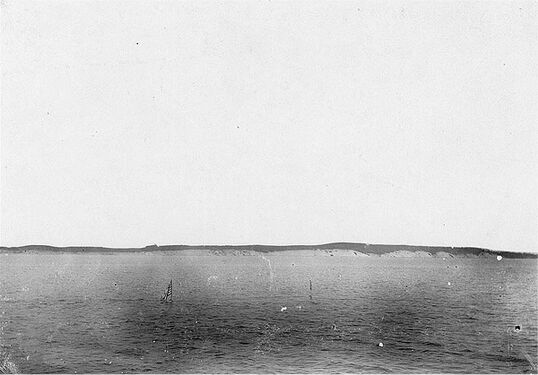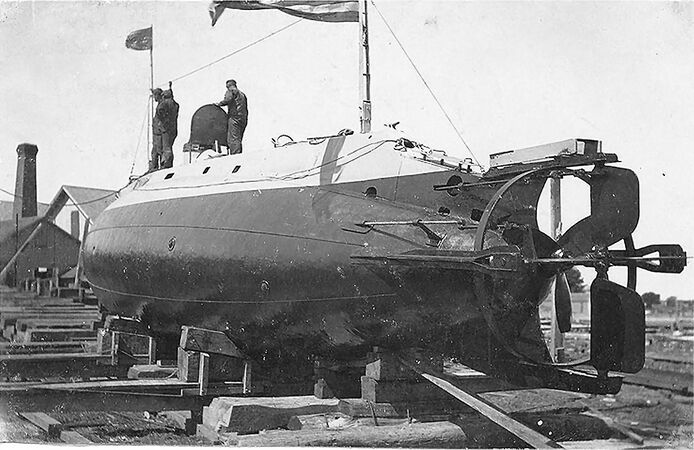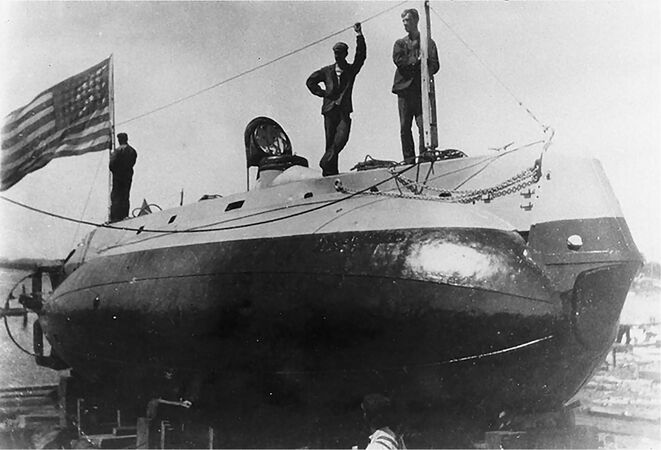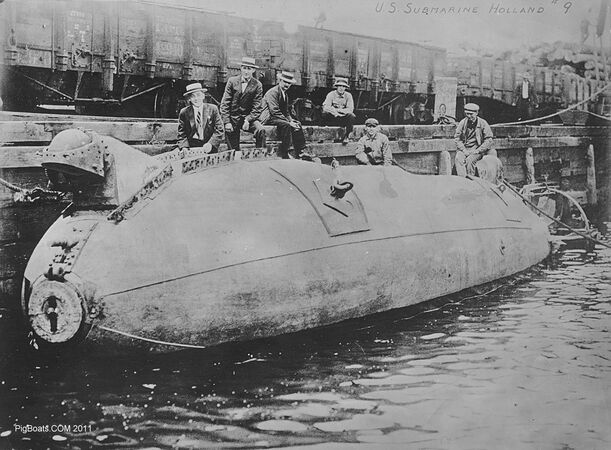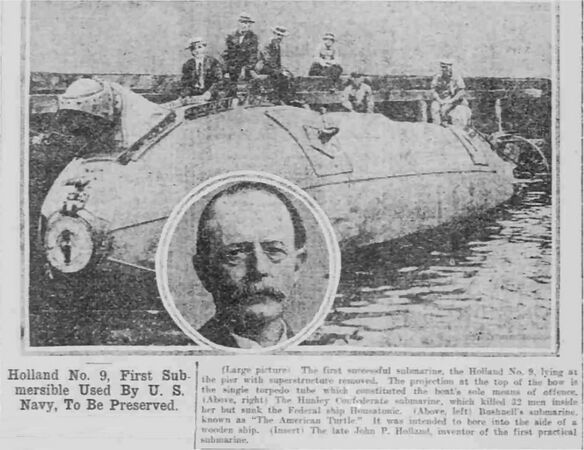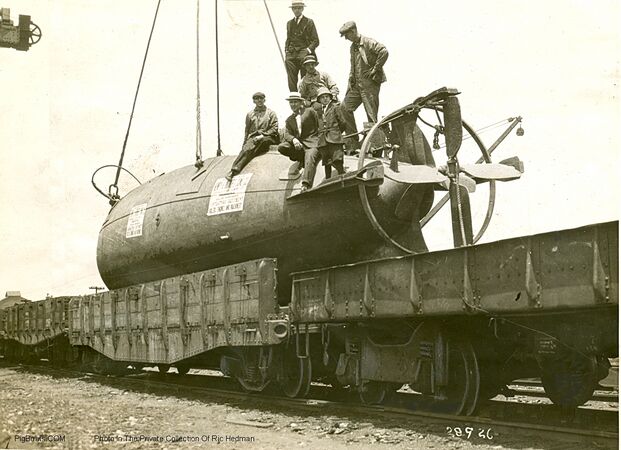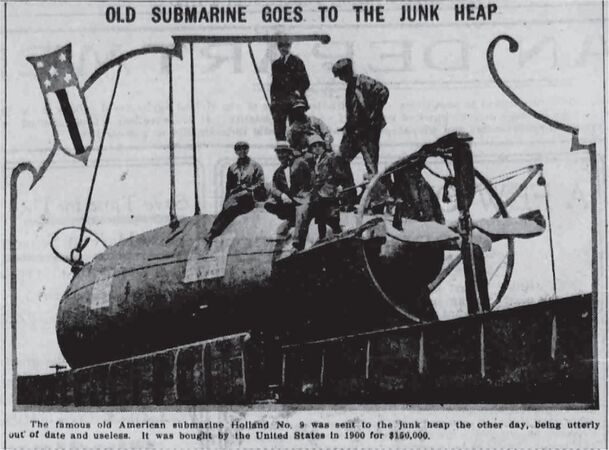Holland
Design, Construction, and Naming Notes
Holland served the USN quite well as a technology and concept demonstrator. However, despite her leading-edge qualities, she was quickly eclipsed by the rapidly evolving submarine technology and was laid up and decommissioned on November 21, 1910. Her stripped out hulk lingered as a traveling exhibit for various private organizations until 1932, when she was unceremoniously scrapped. It is indeed sad that her historical value could not be recognized at the time. She would have made a fine exhibit at the Smithsonian.
Because of her decommissioning date she was not affected by the Navy's change in naming convention for submarines that went into effect on November 17, 1911 and the change in designation systems that was put into place on July 17, 1920. As a result, Holland was known throughout her service life as Holland (Submarine No. 1). Even the common prefix of USS (United States Ship) was not officially adopted until 1909. She never officially carried the designation SS-1 at any point in her career, although many historians will retroactively apply it for continuity purposes. PigBoats.COM will adhere to the official Navy policy that was in effect during the boat's service career.
An overview of John Holland and the development of the first USN submarine
Construction, Launch, and Early Testing
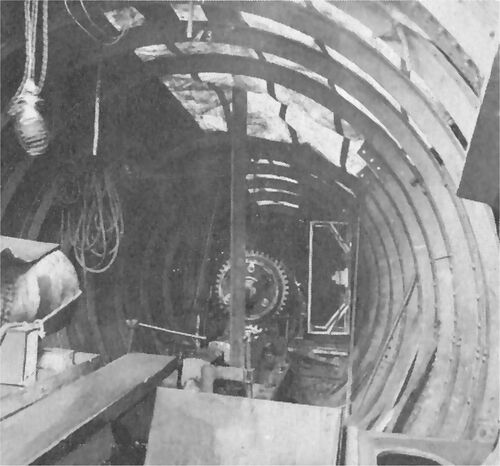
U.S. Navy Photo
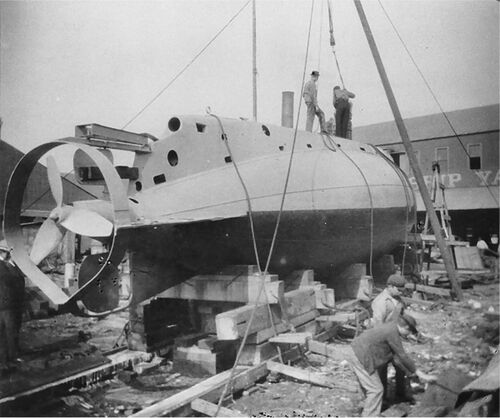
U.S. Navy Photo
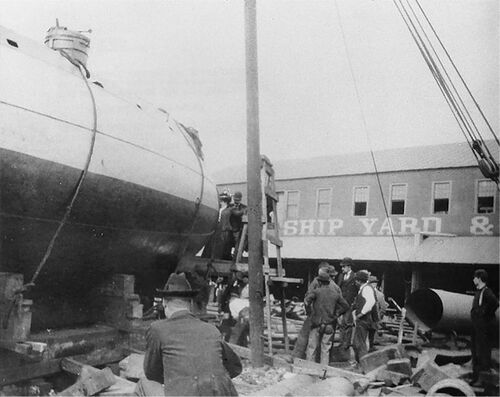
U.S. Navy Photo
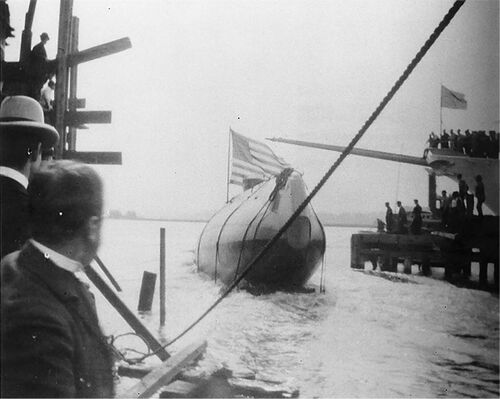
U.S. Navy Photo
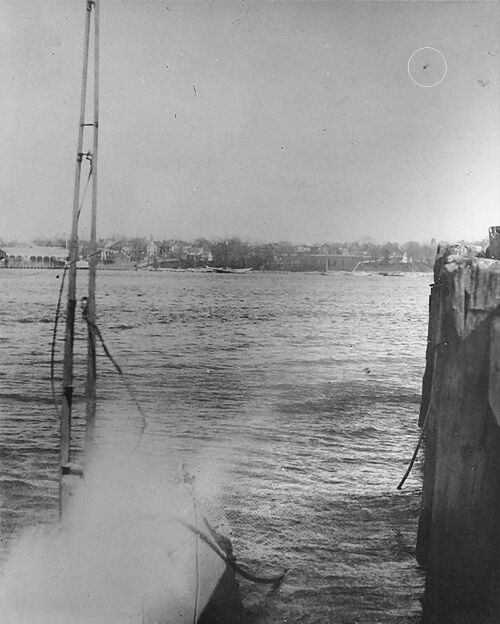
The gun was also fully capable of being fired with the boat just below the surface. The range would be considerably less due to water resistance, but the projectile would break the surface and continue in a ballistic arc. While there is no evidence to show that this was ever actually tested, this capability makes the Holland the first submarine capable of firing a ballistic missile while submerged.
The Zalinski pneumatic gun was innovative but had very limited performance and thus its career with the U.S. military was short. For a good description of the gun and its variations, please see the information at this NavWeaps link, and at this link.
U.S. Navy Photo
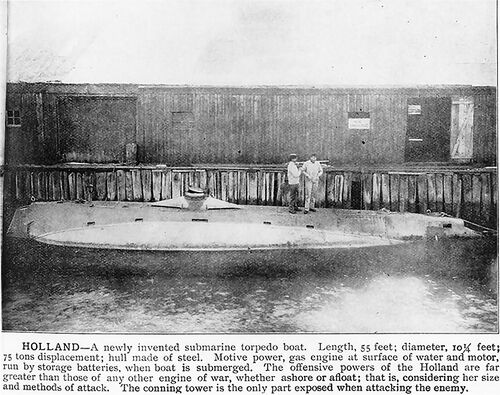
Library of Congress
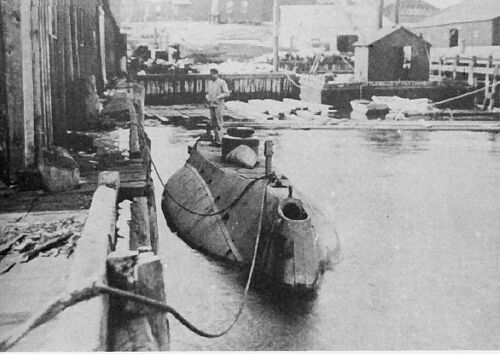
U.S. Navy Photo
The April 20, 1898 Trials
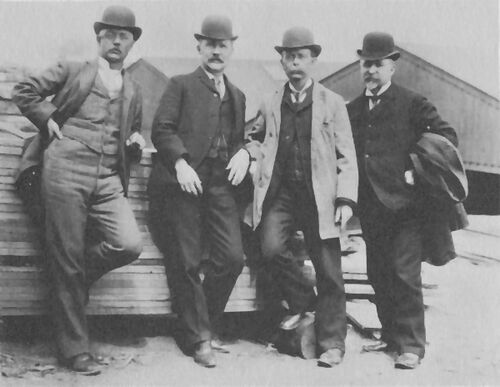
Walter Thompson, superintendent of the Raritan Dry Dock.
Charles A. Morris, superintending engineer of the John P. Holland Torpedo Boat Company.
John P. Holland, inventor of the submarine.
Mr. Matthews, an investor in the John P. Holland Torpedo Boat Company
All there to witness the first real trial run of the submarine boat Holland on Raritan Bay before a Navy Board of Inspection.
US Navy Photo
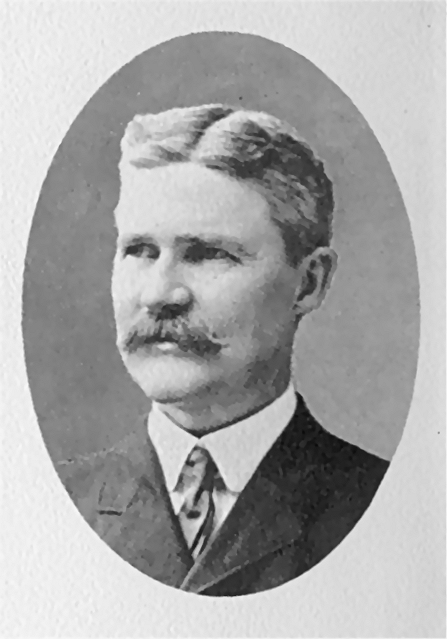
Morris Family Photo
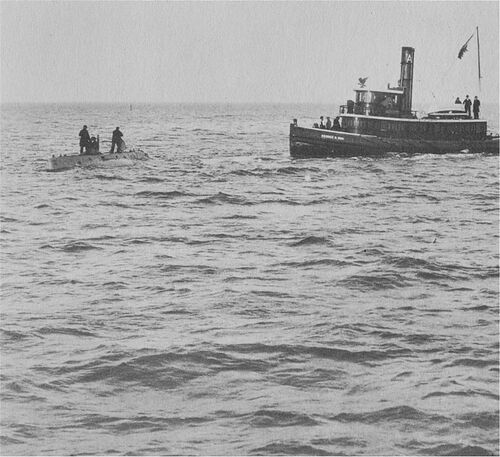
U.S. Navy Photo
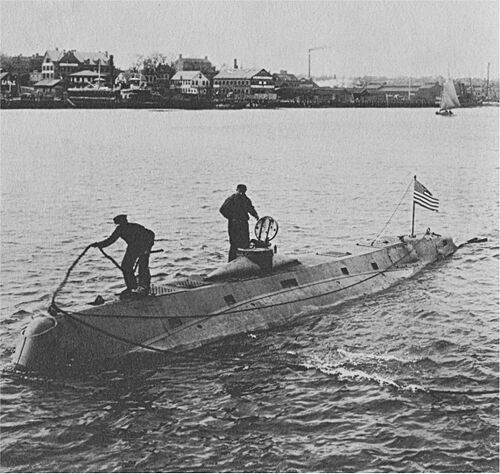
U.S. Navy Photo
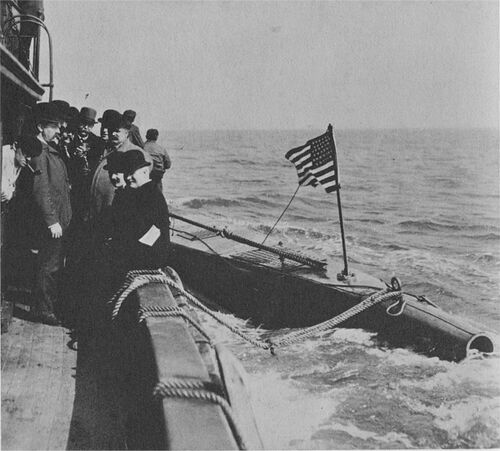
U.S. Navy Photo
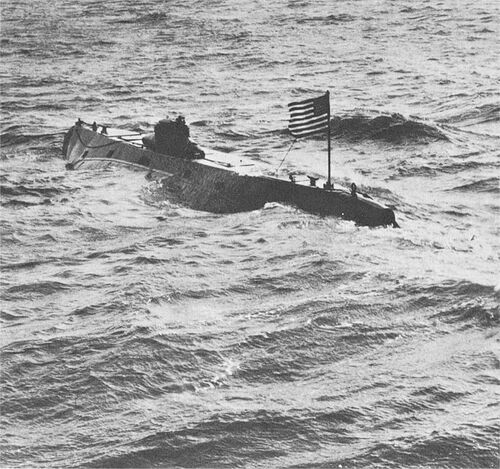
U.S. Navy Photo
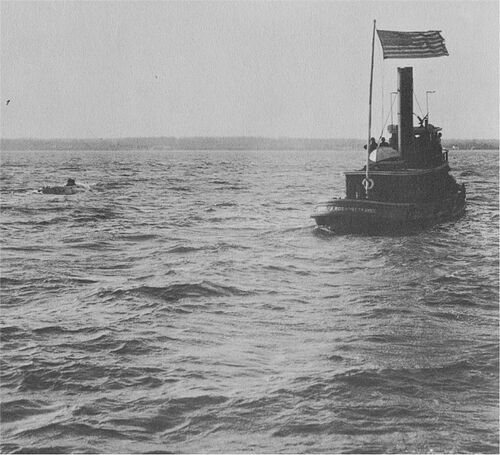
U.S. Navy Photo
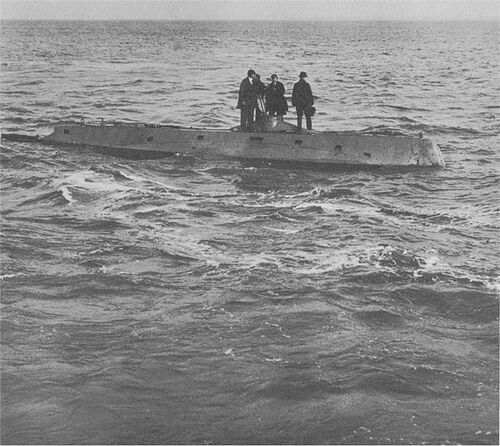
The Erie Basin Haulout
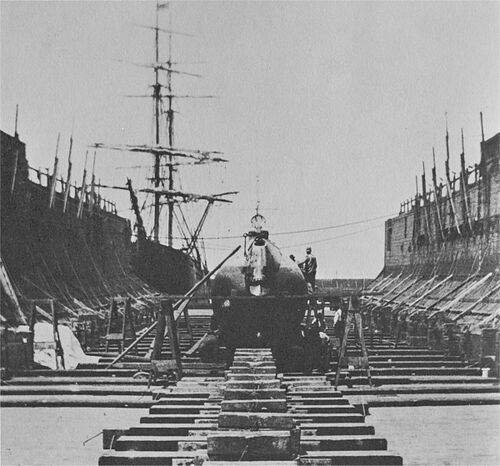
U.S. Navy Photo
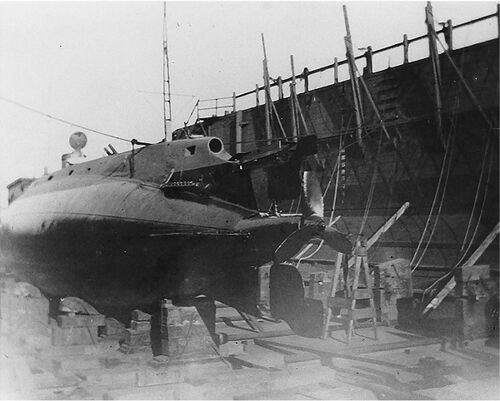
US Navy Photo
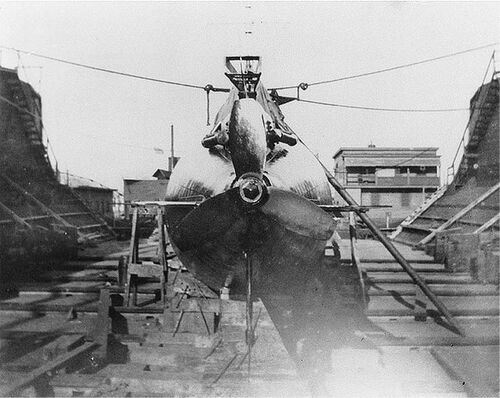
US Navy Photo
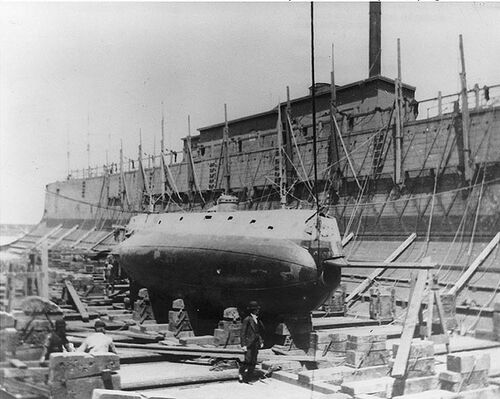
The Atlantic Yacht Basin Haulout
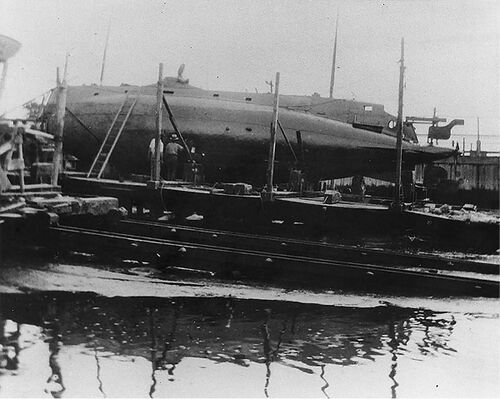
In September 1898 the Holland was hauled out at the Atlantic Basin shipyard and extensive work was done. A new smaller propeller was installed, she received a fresh paint job, and the torpedo tube was re-bored. She was ready for further testing by November 4, 1898. On the 12th of November fresh trials began. This was the first time John Holland did not handle the submarine himself.
US Navy PhotoMorris Heights Haulout
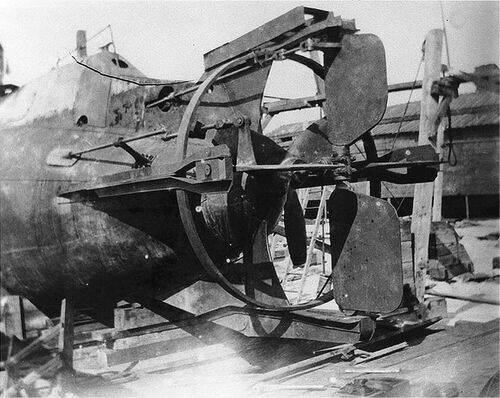
US Navy Photo
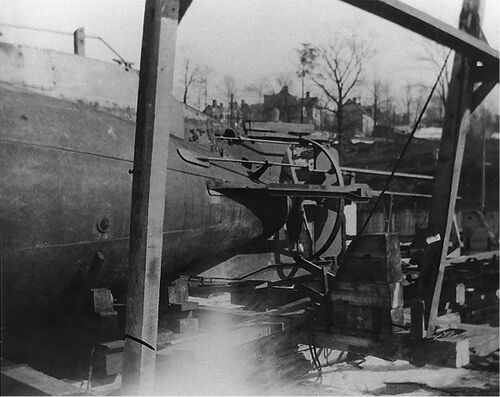
US Navy Photo
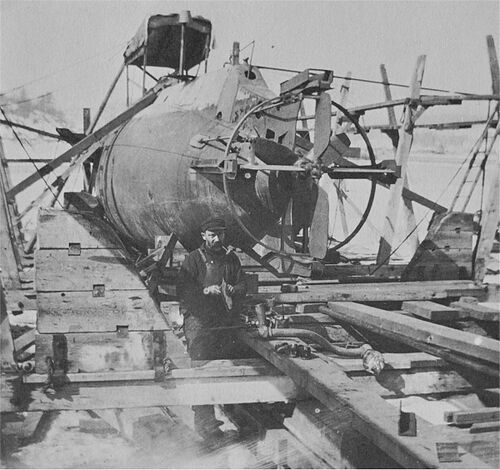
US Navy Photo
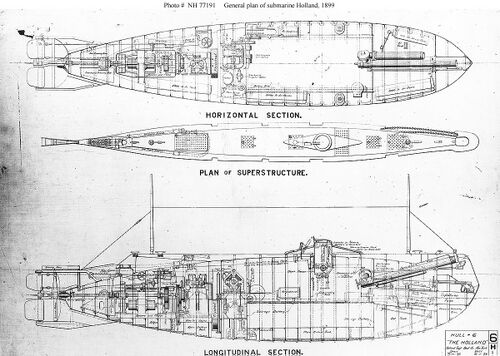
Line drawings of the Holland as she appeared after the work was completed at the Morris Heights haulout. This was the configuration in which she would have her final demonstration to the Navy.
Image NH 77191 courtesy of NHHC.
The New Suffolk Trials 1899
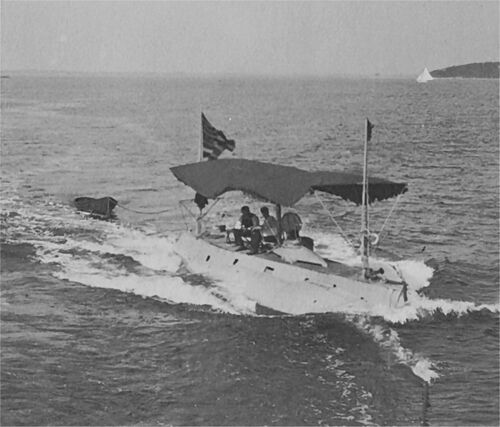
U.S. Navy photo
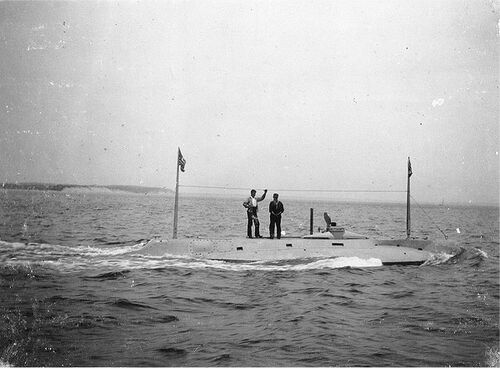
The Holland heading out on Little Peconic bay for trial runs. The course was laid out in a north-south direction parallel to Little Hog Neck and marked by flagged buoys. These photos were taken on an early July 1899 running of that course.
U.S. Navy photo
U.S. Navy photo
U.S. Navy photo
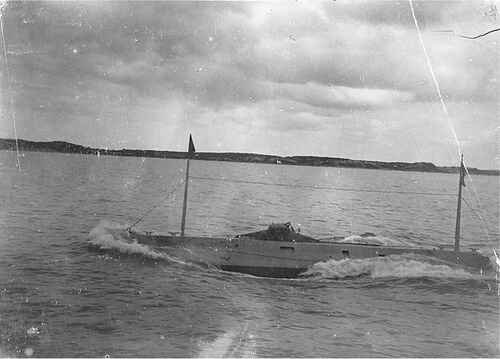
Holland heading back to New Suffolk, NY at the conclusion of the trial run in Little Peconic Bay, July 1899.
U.S. Navy photo
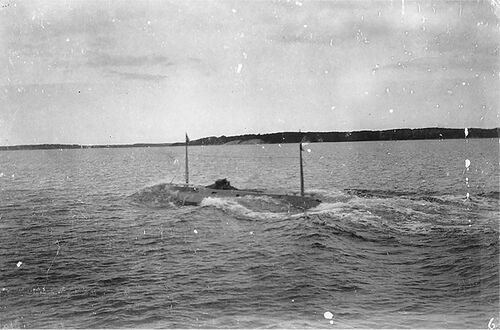
A view from the port quarter as Holland makes her way back to New Suffolk at the end of the trial run.
U.S. Navy photo
The Greenport Haulout
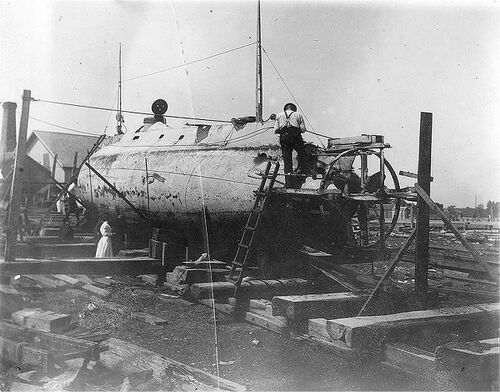
U.S. Navy photo
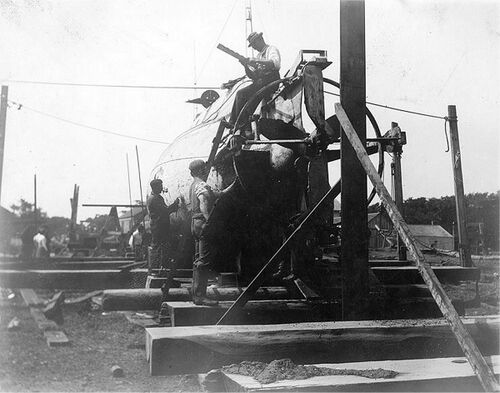
Holland hauled out at Greenport, NY., 1899. This view from the stern shows several Holland Company employees working at her stern.
U.S. Navy photo
U.S. Navy photos
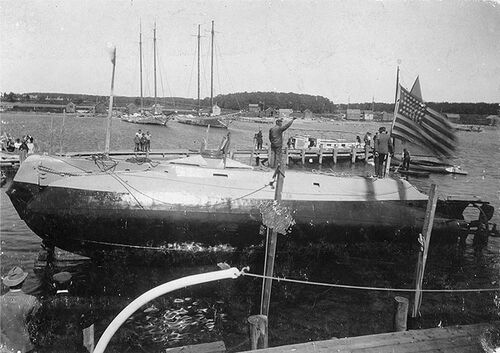
Holland carefully being put back into the water on the marine railway at Greenport, NY, late summer 1899. Different from a traditional launching, the boat was carefully winched back into the water, with the cradle she was sitting on rolling on steel tracks laid on the slip.
U.S. Navy photo

The two workmen in the foreground are painting the hull, getting her into shipshape for the Navy festivities to come.
Public domain image.
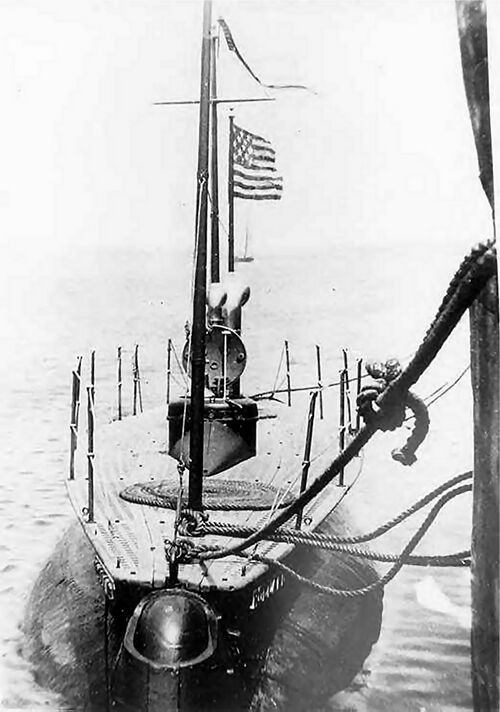
The USS Holland is seen here sometime shortly after her commissioning in the U.S. Navy on October 12, 1900. Her commissioning pennant is flying from her center or "main mast". She also has a temporary deck that John Holland so detested and heavily opposed, believing that they would affect performance. He felt they were only there "for officers to strut upon". The deck shown here was removable and would be left ashore before she headed out. The muzzle cap for her forward pneumatic gun is pointing to the camera.
U.S. Navy photo.
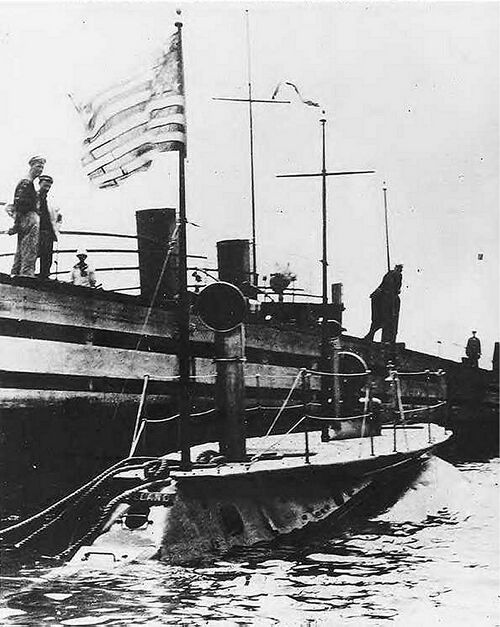
Another view of Holland and her "strutting deck", most likely at the Holland company base at New Suffolk, Long Island. Several crew are on the pier. The second man from the left appears to be Chief of the Boat, Chief Gunner's Mate William H. Reader. The other man is unknown. Moored on the other side of the pier is a motor torpedo boat. On her stern, just below her name plaque is the former opening for her after pneumatic gun that was removed prior to acceptance by the Navy. A hand hold has been placed over the opening.
U.S. Navy photo.
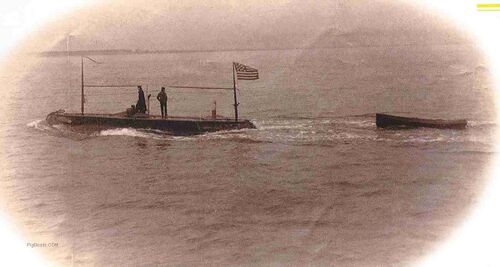
USS Holland underway, based on the background formation, on what seems to be Little Peconic Bay, Long Island, near New Suffolk, late 1900. Several men are topside and the head of the man steering is just seen sticking through the hatch. She is seen towing a skiff that is seen in some other photos. Her commissioning pennant is flying from her foremast and there seems to be a ventilator over the engine area to help air flow to the engine. The two "poles" seen attached to the masts are not booms but boat hooks to assist in coming along side docks and other vessels.
U.S. Navy photo.
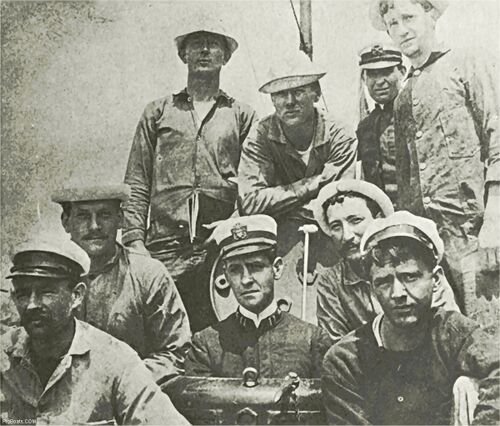
This is the crew of USS Holland, and the first U.S. Navy crew assigned to a submarine. These were brave men operating a futuristic machine on a new frontier. They were pathfinders in the truest sense of that word.
In the center of the picture is Lieutenant Harry H. Caldwell, Commanding Officer (who bears a striking resemblance to actor Gabriel Byrne). Starting at the lower left of the picture and going clockwise are:
•William H. Reader, Chief Gunner's Mate
•Augustus Gumpert, Gunner's Mate
•Harry Wahab, Gunner's Mate 1st Class
•O. Swanson, Gunner's Mate 1st Class
•Owen Hill, Gunner (Warrant Officer)
•Walter A. Hall, Electrician's Mate 2nd Class
•Arthur Callahan, Gunner's Mate 2nd Class
•Barnett Bowie, Chief Machinist's Mate
U.S. Navy photo.
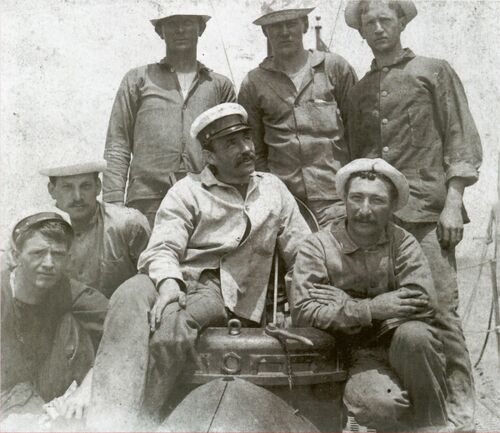
In the U.S. Navy Submarine Service, the Chief of the Boat (COB) is an experienced and wise Chief Petty Officer and the senior enlisted man aboard. He is the principal enlisted advisor to the commanding officer, and is the CO's "get it done man". Not only is he a subject matter expert on all things submarine, but he also keeps the enlisted men moving forward, sometimes with sharp and pointed words, sometimes with a grandfatherly pat on the back and wise insight. This photo highlights the force's very first COB, Chief Gunner's Mate William H. Reader, USN (center). Arrayed around him are the remainder of the Holland's first enlisted crew, the same men in the photo above.
U.S. Navy photo.
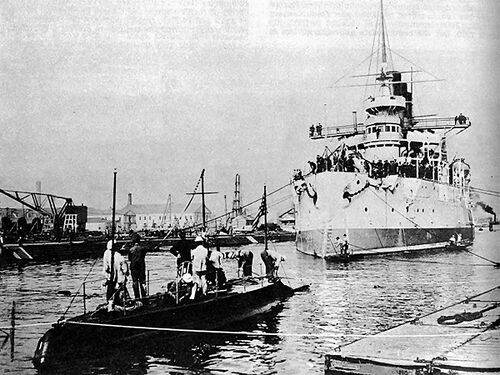
The Holland entering dry dock at the Brooklyn Navy Yard in New York City, October, 1901. She is sharing the dry dock with the Russian battleship Retvizan. The Russian battleship was undergoing a refit prior to heading to join the Russian Pacific fleet at Port Arthur (present day Lushunkou, China). Retvizan had been built for the Imperial Russian Navy by the United States. Retvizan was torpedoed and heavily damaged prior to the famous Battle of Tsushima Straight in the Russo-Japanese War. But she was repaired in time to participate in the battle. She survived and was eventually taken over by the Japanese and renamed Hizen. She served Japan until being sunk as a gunnery target in 1924.
U.S. Navy photo.
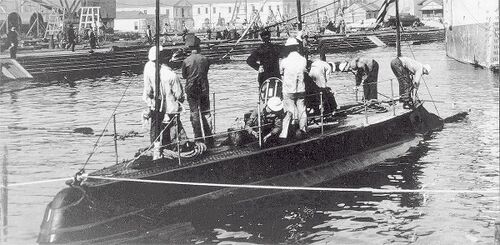
A high resolution closeup of Holland from the above photo. The bow is facing the camera. Her crew is all topside, working to ensure the lines are ready to steady the boat when the dock pumping begins.
U.S. Navy photo.
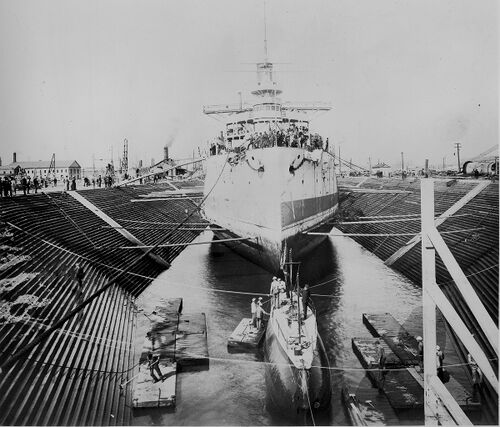
Another view of Holland and Retvizan during the 1901 Brooklyn Navy Yard drydocking. In this photo the water is nearly drained and both ships are sitting firmly on the keel blocks at the bottom of the dock. LT Caldwell can be seen on Holland's deck, carefully monitoring the draining of the water.
U.S. Navy photo.
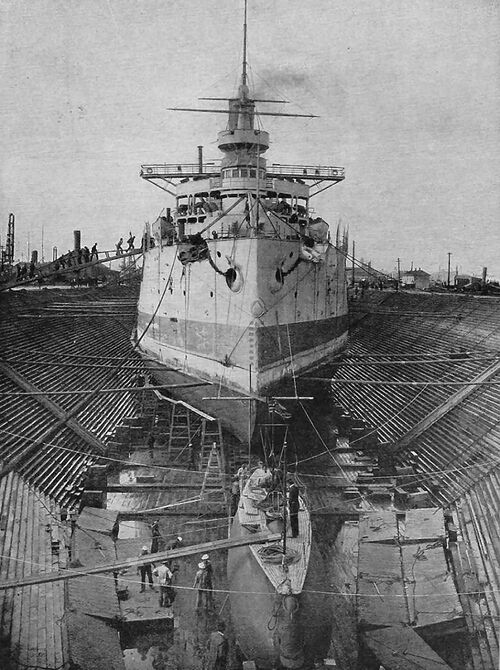
This photo was taken several minutes after the one above, and shows the dock drained. An access gangplank has been placed to provide a means of getting to the Holland. Time would not be wasted and the men would get to work immediately.
U.S. Navy photo.
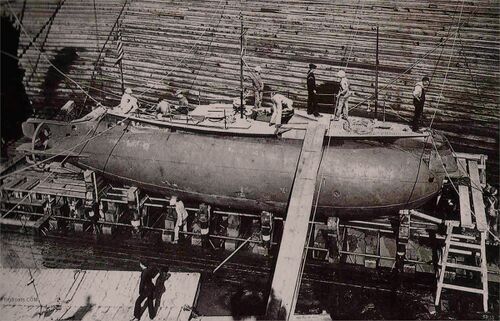
Another view of Holland during the 1901 drydocking. This shot gives a good view of her hull shape, a beautifully tapered cylinder. The Navy would quickly diverge from this hydrodynamically optimal shape, but would return to it in the 1960's and the Skipjack-class nuclear submarines with their "Albacore" style hulls.
U.S. Navy photo.
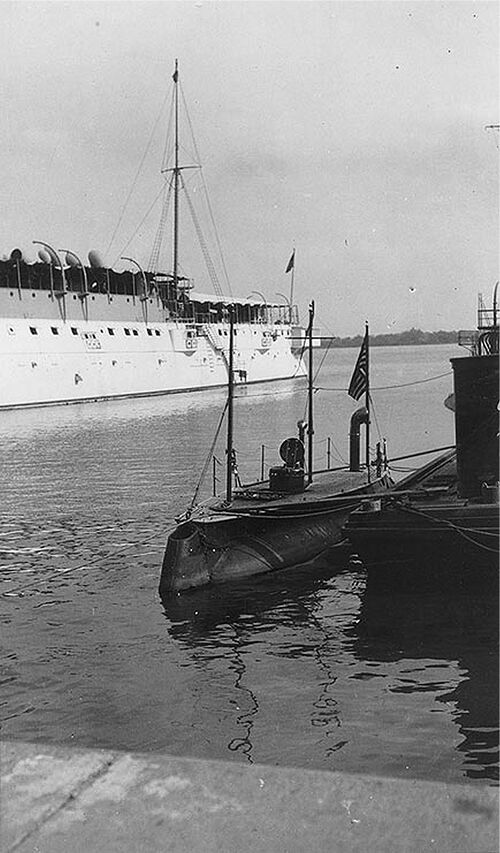
The diminutive Holland moored at the Philadelphia Navy Yard in 1901. USS Columbia (Cruiser No. 12) is partially visible in the background. The muzzle door for Holland's pneumatic gun is open. Theoretically, the gun was capable of launching it's dynamite shells while the boat was submerged, making the Holland the first submarine capable of launching a ballistic missile while submerged! While there is only anecdotal evidence to show that she actually did launch a projectile while submerged, she was certainly capable of doing so.
U.S. Navy photo.
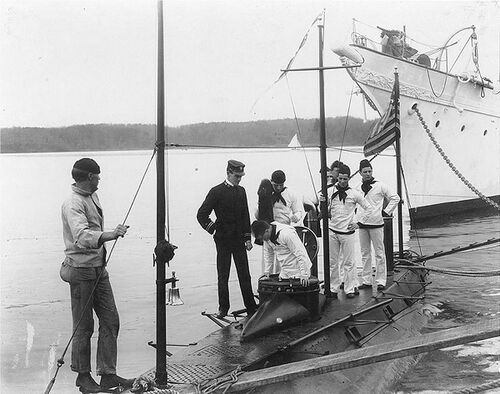
At the U.S. Naval Academy, Annapolis, Maryland, circa 1901-1902, with several midshipmen on board. Among the midshipmen are, as identified from names on their uniforms:
•Naval Cadet Henry G.S. Wallace (entering conning tower)
•Naval Cadet John W. Woodruff (behind Wallace)
•Naval Cadet John. H. Blackburn (by the mast) and
•Naval Cadet William J. Moses (in front of the flag).
The careful method that Wallace is using to go down the hatch emphasizes the boat's small size and the fact that you did not enter the Holland, you put it on.
The officer standing by the conning tower is probably Holland's Commanding Officer, Lieutenant Harry H. Caldwell. Note Holland's bell mounted on her foremast, commissioning pennant flying from the top of her mainmast, outriggers fixed along her deck edge for decking that has been removed and the bow of the converted yacht USS Gloucester in the right background.
U.S. Navy photo.
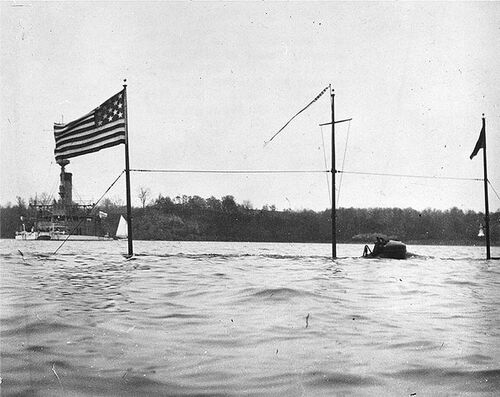
Holland partially submerged in the Severn River off the U.S. Naval Academy, Annapolis, Maryland, in the summer of 1901. Maybe with cadets aboard as riders. Note the submarine's 13-star "boat" flag, signal mast fitted amidships and commissioning pennant. A large coastal monitor, possibly an Amphitrite-class vessel, is in the left background.
U.S. Navy photo.
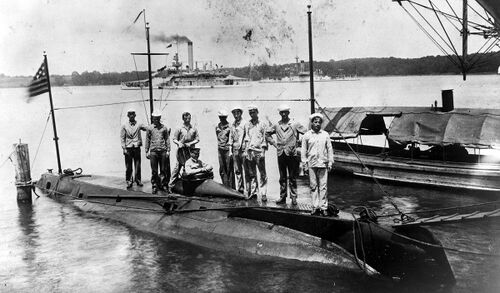
Holland and her crew posing for a portrait while stationed at the Naval Academy circa 1903-1904. Two coastal defense monitors are anchored in the background, a steam launch is moored alongside as a comparison for size. The left hand monitor is an Arkansas-class vessel, and the other is of the Amphitrite-class.
U.S. Navy photo.
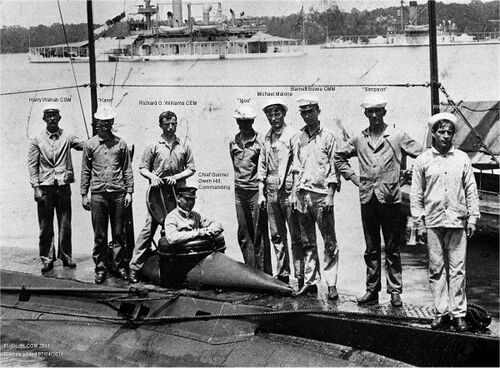
A closeup of the photo above, with callouts for the crew's names. By this time Gunner Owen Hill had taken over as Commanding Officer, a very rare occasion in which a warrant officer commanded a commissioned warship.
U.S. Navy photo.
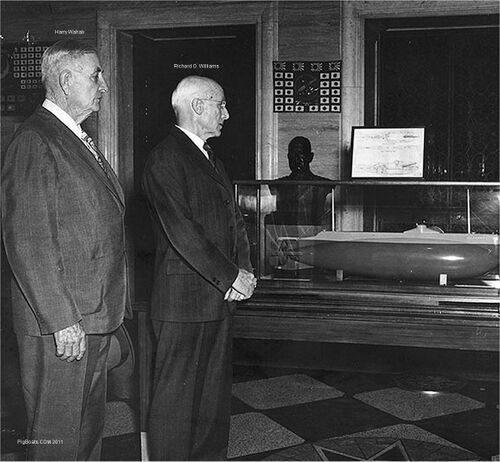
Harry Wahab and Richard O. Williams, two of Holland's crewmen, seen here on April 11, 1947 at the Naval Academy at Annapolis. They stand by a model of the Holland, the Navy's first submarine, which had been accepted for service 47 years previously.
U.S. Navy photo.
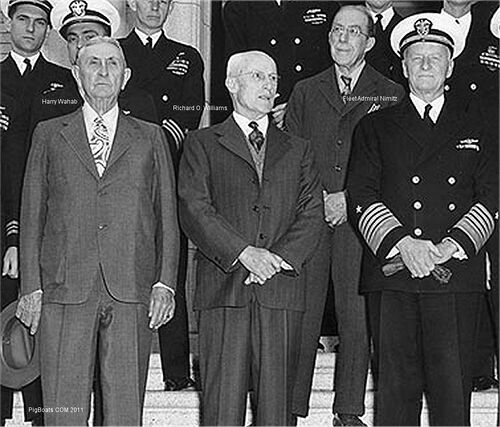
Wahab and Williams in the company of a distinguished guest, Fleet Admiral Chester W. Nimitz at the Naval Academy, April 11, 1947. At the time of the photo Nimitz was the Chief of Naval Operations at the Pentagon. Nimitz was also a submariner, and commanded one of the Holland's follow-on boats, the USS Plunger (Submarine No. 2) in 1909.
U.S. Navy photo.
The Twilight of a Career

Photo courtesy of NARA.
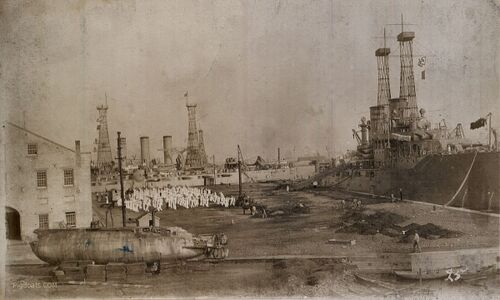
The ex-USS Holland hauled out at the Norfolk Navy Yard, Portsmouth, VA. The Holland had been struck from the Navy List on November 21, 1910, but her hulk lingered at the yard for several years. The men in the photo are in dress whites making this photo taken after Memorial Day, probably in 1911 since there isn't much taken from the Holland, just a few panels. The fairing in the bow and the fairing that surrounded the conning tower is gone as well.
The ship on the right in the photo is a Delaware-class battleship, either the Delaware (BB-28) or the North Dakota (BB-29). The ship in the background is a Virginia-class battleship, either the Georgia (BB-15) or the New Jersey (BB-16). The crew on the dock could be from any ship in the area.
Thanks to Charles Haberlein for identification.
Photo in the private collection of Ric Hedman.
-
Photo in the private collection of Ric Hedman.
-
New-York Tribune/Library of Congress image.
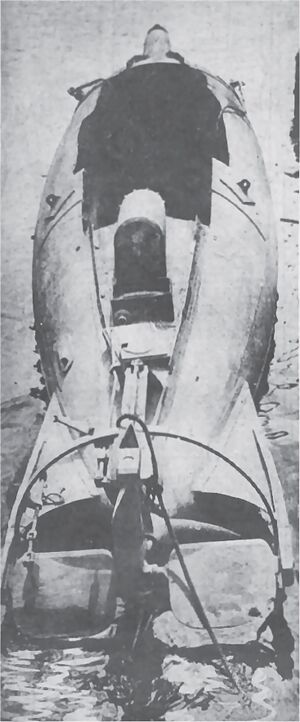
Stripped out hulk of the ex-Holland awaiting the end. The remnants of the after Zalinsky gun housing can be seen. The gun was removed before final Navy acceptance trials.
Evening Public Ledger.(Philadelphia)/Library of Congress image.

ex-Holland being lifted to a rail car for transport, June 1915. The attached signs are apparently for the scrap company that now owned her.
Image Contributed by Gary McCue.
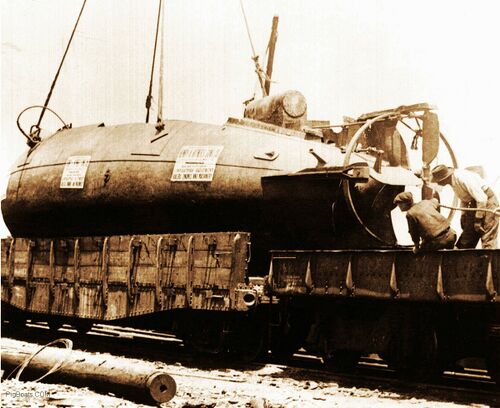
ex-Holland now on the blocks for transport by rail car, June 1915. Workmen are inspecting the positioning of the boat to ensure it is properly placed for transport.
Image Contributed by Gary McCue.
-
Photo in the private collection of Ric Hedman.
-
Iron County Record (Cedar City, Utah)/Library of Congress image.
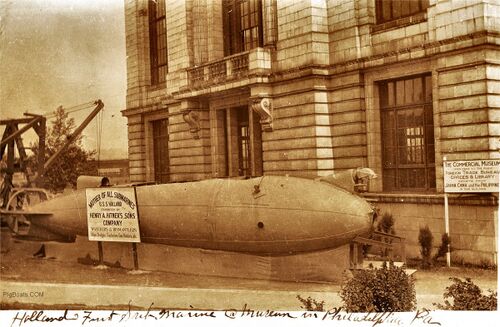
This photo shows the ex-Holland on display outside of the Commercial Museum in Philadelphia, approximately 1915. Her hulk is owned by the Henry A. Hitner & Sons Company, a scrap firm. Realizing the commercial value of the old boat, they put it on display trying to earn some money off of it.
There is a platform built at the front of the submarine so visitors can look inside the sub through the torpedo tube opening. The tube and outer door had been removed by the Navy at decommissioning.
This photo is distorting the actual shape of the boat, making it appear to be longer and thinner than it actually was. It is probably an artifact of the photography process.
Image Contributed by Gary McCue.
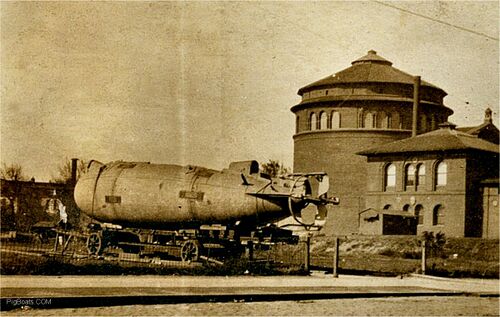
The ex-Holland in Philadelphia at what is today the University of Pennsylvania Museum across the street from Franklin Field. The submarine is sitting on what will become part of museum building. It appears from this photo that South Street was at one time closer to the museum building than it is today.
Compare images above with this one and you will see iron "straps" riveted to the hull fore and aft where the hull has been cut apart for transportation and then rejoined. In all the images to follow you will see these straps.
Image Contributed by Gary McCue.
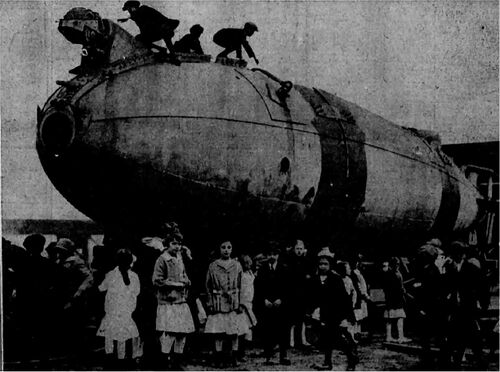
In August of 1916 she was privately purchased from Hitner by a Dr. Peter J. Gibbons and his son for $350.00 to be used for display and possibly placed in a museum. Here in this October 17, 1916 photo and newspaper story, "OLD SUBMARINE PROVES A HARMLESS TOY FOR SCHOOL CHILDREN" "Children of the McCall School paid a visit to the submarine Holland (SS-01), the first sub-sea craft in the United States Navy. The Holland is reposing, like a stranded amphibian, in the empty lots opposite Franklin Field before it goes to the Irish bazaar, in New York."
Evening Public Ledger.(Philadelphia)/Library of Congress image.
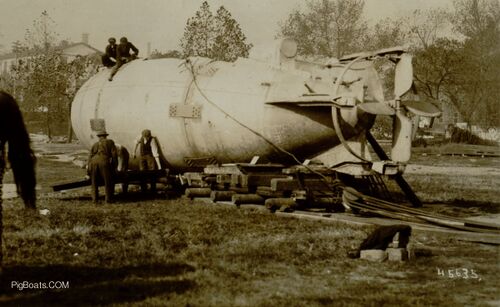
The ex-Holland is being prepared for transport to be in the Columbus Day Parade in Philadelphia, so the date has to be just prior to October 12, 1916.
The two cuts made in the hull to transport it to this location are clearly seen. The straps that riveted the hull sections back together are also clearly visible. The submarine appears to have been cut to move her from the Philadelphia Commercial Museum to the University of Pennsylvania Museum. Workmen are placing roller logs under the cradle and a large block and tackle have been rigged to the hull.
Photo in the private collection of Ric Hedman.
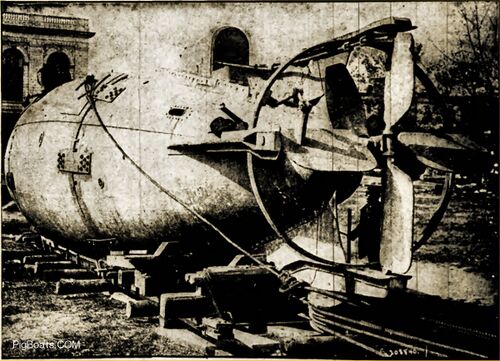
A photo from the Boston Courier newspaper taken some time shortly after the photo above was taken shows the logs in place and the slack taken up in the block and tackle ready to move the submarine. Part of the University of Pennsylvania Museum can be seen in the background.
Photo from the Buffalo Courier, October 29, 1916.
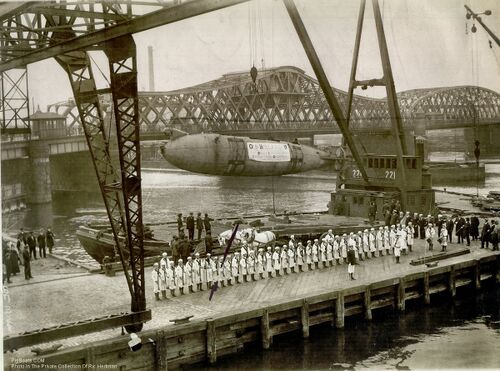
May 25, 1917 the ex-Holland is lifted from a barge on its way to the Bronx International Exposition. The bridge in the background is the Willis Avenue Bridge from Manhattan to the Bronx and is still there looking almost the same. The Bronx is to the right in this photo. The pier is located at 125th Street and the Harlem River. The group in uniform is a contingent of the Junior Naval Reserve and is there as an honor guard.
The sign reads: "Old Holland #9; Daddy Of All Submarines; (unreadable words); Bronx International Exposition Grounds; 177st Subway Station & Bronx River". Again, the misunderstanding about what build number the ex-Holland was. The ex-Holland was hull #6 not #9 in John Holland's design scheme and was the one the Navy bought. The Holland was to remain at this spot, as a derelict hulk until 1932 when she was purchased by the Harlem Metal Corporation for $100 and cut up for scrap. It was a sad end for such a historic vessel, and a complete shame that she was not preserved as a museum.
Photo in the private collection of Ric Hedman.
Page created by:
Ric Hedman & David Johnston
1999 - 2023 - PigBoats.COM©
Mountlake Terrace, WA, Norfolk, VA
webmaster at pigboats dot com

